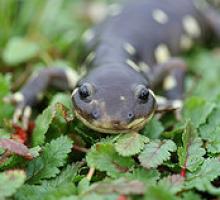California’s Central Valley supports over 20 endemic, special-status species associated with vernal pools and seasonal wetlands, yet loss of 90% of the original extent of these habitats has resulted in highly-fragmented, remnant pools of varying habitat quality. Managers need science support to inform conservation priorities and possible enhancement of remaining pools, particularly since projected increases in temperature and decreases in precipitation may dry ponds to an extent that reduces or precludes their habitat value. Ongoing changes in climate will, in turn, cause changes in hydrologic regime, with a decreased hydroperiod expected to detrimentally affect reproductive occupancy of special status species such as the California tiger salamander. The relationship between changing climate and hydrologic regime of vernal pools has not been studied, but may be crucial for continued persistence of vernal pool species.
This project will examine the pool characteristics (pond duration and timing, water quality, turbidity) and upland characteristics (habitat type, soil type, dry matter) related with occupancy of pools by CTS larvae and metamorphs at a local scale comprised of both private (Conservation Bank) and public (FWS Refuge) lands. Project scientists will use occupancy models and model selection techniques to evaluate pool and upland characteristics that increase metamorphic occupancy in relation to hydroperiod (Maret et al. 2006, Johnson et al. 2013), using existing datasets to identify key needs, augmented with new data to expand the range in observed variation in predictor variables to develop robust predictive models. The project will then develop and validate predictive models for current conditions and multiple climate scenarios that project salamander occupancy as a function of hydroperiod, itself related with evaporation and runoff as a function of catchment area, pool size, and upland land cover. This predictive framework uses more intensive field-based and remote sensing inputs on refuge lands, and explores models that leverage remote sensing and weather data on private lands over a regional scale for which field- based data may not be available.
The effort focuses on the San Joaquin Valley portion of California’s Central Valley since this area is lacking information, and for example, is almost entirely devoid of prior scientific studies on Central California Distinct Population Segment of the California tiger salamander (henceforth, California tiger salamander, CTS), yet is under substantial threat since the majority of remaining vernal pool habitats occur on private lands. By integrating existing field-based, remote-sensing, and GIS datasets, the project will identify important habitat and landscape features needed by managers to prioritize management and conservation actions for amphibians, including a special-status species, facing changes in climate in this critically endangered ecosystem.

